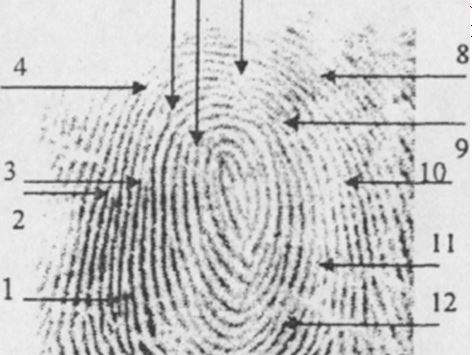Fixation of fingerprints. Since fingerprints cannot be removed, they must be captured using photography and properly selected lighting. Separate four options for lighting conditions: reflected, passing, shooting on a dark or light background, combined.

To increase the contrast of the image when photographing handprints in transmitted light, special lighting is used according to the dark field method with a central aperture. On a dark background (or by the dark field method), low-contrast traces are photographed that require an increase in image clarity. Photography of colorless traces on transparent objects made of glass, crystal, plastic and similar materials is usually carried out in transmitted light using the dark field method. By changing the position of the illuminators, which are located behind the photographed object, the papillary lines become distinguished on the frosted glass in the form of bright white lines. Sweat marks found on transparent glass are photographed in transmitted light. Sweat marks found on glossy surfaces (polished caskets, glassware, etc.) are photographed, as a rule, in reflected light. Relief traces are photographed under indirect illumination, the light source should be located at an acute angle relative to the surface. If the substance of the trace and the background have a similar color, then you need to use lighting that is close to vertical.
The luminescence of sweat-fat substance can be registered in different regions of the spectrum. To obtain luminescence in the visible part of the spectrum, an object must be irradiated with monochromatic light having different wavelengths.
Experiments have shown that good results in the detection of handprints can be obtained using a continuous-wave argon laser that produces blue-green light: the object is illuminated by laser radiation through an expander lens, and the area of the footprint is photographed. There is a fundamental possibility, thanks to laser irradiation, to determine the antiquity of the formation of a sweat-fat trace of papillary lines, since subsequently the luminescence changes from a yellow-green glow to orange. The study is carried out in a darkened room. Barrier light filters are installed in front of the camera lens, which do not transmit light waves with a laser beam length.iya.inirovanie and pass green-yellow or orange color, which luminesce traces.
Photographing traces on multi-colored surfaces is carried out using light filters in the UFP and IChP. The purpose of ultraviolet irradiation of traces is to increase the contrast of the image, to obtain benign photographs when photographing on multi-color surfaces. IPI imaging is used to detect objects containing graphite or carbon or having a different reflectivity in the infrared spectrum compared to the visible
For the study of old traces left on paper or cardboard, as well as in cases where traces are on surfaces whose color precludes the possibility of obtaining high-quality photographs, treatment with radioactive material is used.
This technique is applicable to the detection of traces of antiquity for at least two months, since organic components of the sweat-fatty substance can dissolve in more recent traces.
How do you need to capture fingerprints.
 >
>
